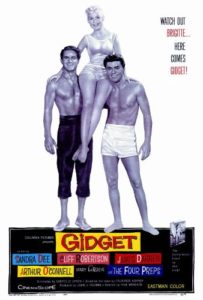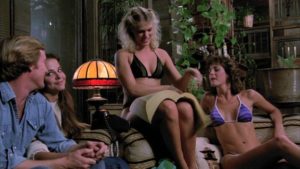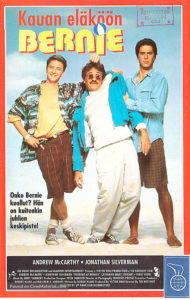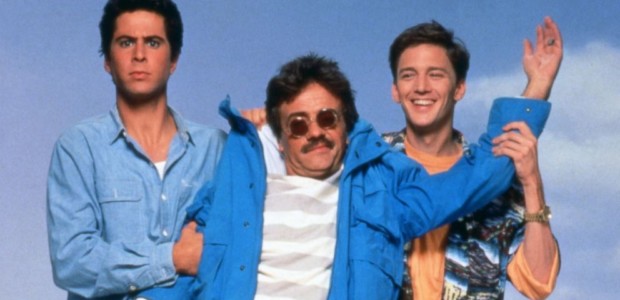Upon its release, WEEKEND AT BERNIE’S was panned by critics but held its own at the box office, grossing a respectable 30.2 million dollars (against a 6.5 million dollar budget) in the summer of 1989. With the release of INDIANA JONES AND THE LAST CRUSADE, STAR TREK V: THE FINAL FRONTIER, GHOSTBUSTERS II, LETHAL WEAPON II, THE KARATE KID and new adventures for pop culture icons James Bond, Jason Voorhees, and Freddy Krueger, 1989 had been christened “the summer of the sequel.” It was a crowded summer at the movies with BATMAN, DO THE RIGHT THING, THE ABYSS, and PARENTHOOD showing up to the party as well. The decade was coming to a close and times and tastes were beginning to change within American culture. The party-time ‘80s were soon going to give way to Generation X cynicism which tied to a notion of social and political awareness in youth culture. WEEKEND AT BERNIE’S was one of the last great beach comedies, representing the end of an era and said goodbye to the ‘80s.
The teenager as we know it came to be in the ‘50s, forming their own subculture of rebellion, sex, and rock ‘n’ roll. From beatniks to bobbysoxers, from greasers to hipsters, the teenagers of the ‘50s were living in a relatively idyllic time: America was at peace, television made its way into the home, and more and more suburban developments were popping up every day. The teenager was influencing pop culture tastes like never before and it wasn’t long before the madmen of advertising started figuring how to appeal to this new brand of consumer with expendable income. Filmmakers saw this too, leading to an influx of monster movies—prime for making out in a theatre—and lurid exploitation action films and comedies rife with allusions to sexuality centered around rebellious teenagers on the make.

GIDGET and GIDGET GOES HAWAIIAN, and GHOST OF DRAGSTRIP HOLLOW were ground zero for beach party films that would become synonymous with the ‘60s, but it’s 1963’s BEACH PARTY that is credited with being the film that introduced the world to the genre. Featuring Frankie Avalon and Annette Funicello, BEACH PARTY was inspired by a forgotten Italian film that American International Pictures head Samual Arkoff saw overseas and featured a middle-aged man who falls in love with a young lady at a beach resort. The filmmakers were taken by the setting and, in line with the advertising executives of the day, figured out a way to sell it to teenagers. American International Pictures built on the film’s success throughout the ‘60s, adhering to the simple formula of the beach, teenagers, sex, and rock & roll, releasing 12 films in the series and inspiring countless rip-offs. The whole gang even returned during the ’80s glut of beach comedies with 1987’s BACK TO THE BEACH.

Outside of a few outliers, the beach party film subsided throughout the ‘70s but was reborn in the ‘80s, advent of the R-rating allowing filmmakers to take a more lurid approach to the films offering up more explicit sex and bare boobs and butts galore than their Frankie and Annette counterparts. This new wave of beach party films arguably started with 1982’s THE BEACH GIRLS (interestingly enough, told from the girls’ point of view albeit by male writers) and their popularity owed quite a bit to both the video store and late night airings on cable television. The ‘50s nostalgia of the ‘70s gave way to ‘80’s nostalgia for the ‘60s, and the boomer filmmakers of the Reagan-era attempted to recapture just a little bit of that good-time magic. Much like the ‘50s, pop culture of the ‘80s presented the perceived notion of a prosperous time for America….even if we were scared of Russia again. It was a relatively peaceful time and—for better or worse—the yuppie mantra of greed is good greatly inspired reckless consumerism throughout the decade. When Ronald Reagan mandated that the FTC would no longer have any authority to regulate advertising and marketing, children and teenagers were introduced to a world of pop culture unlike anything any generation had seen before, from film to toys to television to music, look no further than the popularity of Stranger Things to witness the fetishization of all things ‘80s that still sells toys and t-shirts today.

HOT MOVIES, HARDBODIES, SPRING BREAK, and PRIVATE RESORT—featuring horny boys on the make alongside buxom babes in bikinis in a beachside vacation setting—were unleashed on theaters during the first half of the decade, setting the template for countless imitators while WHERE THE BOYS ARE ‘84 flipped the script featuring a gaggle of girls on the prowl. For the casual viewer, these films are nearly indiscernible with their good looking casts descending upon the beaches of California and Florida looking to get drunk, get laid, and party. This style of film was ubiquitous with the ‘80s and thanks to the advent of cable television and the home video cassette and introduced countless adolescents to their first glimpse of a nipple. From the Risky Business-inspired typeface on the logo to the interior design choices in Lomax’s Hampton Island pad, and down to the party reggae-tinged “Hot And Cold (Theme From Weekend At Bernie’s)”—co-written by the Police’s Andy Summers and performed by Jermaine Stewart, WEEKEND AT BERNIE’S represents the last sun-drenched gasps of the wacky beach comedy.
The PG-13 WEEKEND AT BERNIE’S is considerably less raunchy than it’s more low-rent counterparts—Bernie is the only character who actually gets laid—but implies the promise of casual sex and casual drug use within that same summertime party vibe, keeping in line with the beach party film’s aesthetics. Teen Movie Hell author and film historian Mike McPadden explains that despite the characters in the film being older, the film is very much a “teen sex comedy” as they all behave like teenagers. All of the classic beach movie elements are in full swing: buxom babes in bikinis, a pair of schmucks looking for fun in the sun, and sand and surf. For teenagers and adults alike, the beach represents an absence of responsibilities, an escape. The physical manifestation of the cliche to work hard and play hard.
While working for the weekend from a tar drench New York rooftop, twenty-something corporate cogs Richard Parker (Jonathan Silverman) and Larry Wilson (Andrew McCarthy) discover that someone is stealing from the insurance company they work for. When it’s revealed that it is, in fact, their boss, the titular Bernie Lomax (Terry Kiser) that is defrauding the company, he invites them out to his beach house for the weekend and puts a hit on them. The mobsters Bernie is in cahoots with deciding against the incident with the two guys and off Bernie instead.
When this Odd Couple for the ‘80s make it to Bernie’s on Friday afternoon and discover he’s dead, Larry, the sloppy wilder Oscar in a Hawaiian shirt and Converse to Richard’s more fastidious, level-headed Felix in a tasteful linen blazer—suggests that two simply pretend Bernie didn’t die so that they can enjoy their weekend, a plan Richard scoffs at until Gwen (Catherine Mary Stweart), Richard’s co-worker and object of affection, makes an appearance at the party. From then on, the film becomes a TROUBLE WITH HARRY-inspired, slapstick comedy of errors that finds our heroes attempting to convince everyone around them that Bernie is alive—including mob hitman Paulie who is certain that he succeeded in putting Bernie down.

At the time of its release, Roger Ebert accused WEEKEND AT BERNIE’S of being a one-joke movie, and while even Silverman flippantly told Larry King “It’s about a guy who dies on page twenty and we drag him around the Hamptons for the rest of the weekend” but considering Bernie isn’t dead until somewhere around the half-hour mark, that feels like a disservice to the film.
As much a quintessential New York movie as a beach party film, BERNIE’S spends the first half-hour in the Big Apple, getting to know Richard and Larry. Their friendship is one built of the workplace, the kind of relationship we’ve all had where we’re not sure how we became best friends with this person, but here we are. The more fastidious Richard and sloppy Larry make them an Odd Couple for the ‘80s, and that friendship feels real. Eating hot dogs from a cart on the street, the guys crack wise about New York City noting that Bernie’s car costs more than Larry’s cockroach infested apartment because the car is, in fact, bigger than the apartment. When Richard brings Gwen home to his parent’s apartment, Richard is embarrassed by the ‘60s style of decorating, which in a time when hip young people fetishize mid-century modern design, brings another level to the joke. Gwen, ahead of her time, finds it to be “very hip.”
During the floating party that makes its way to Bernie’s pad upon Larry and Richard’s arrival on the island, the film is loaded with on the nose job parody of rich New Yorkers, partying in the Hamptons for the weekend. So many selfish, vapid people—a John McEnroe clone haggles over the price of a Maserati, a chain-smoking writer details her new book about Sherlock Holmes and Watson being secretly married—so into themselves that they never realize that rigor mortis is setting in on their host. This skewering of ‘80s yuppie culture offers up a time capsule of a city long-gone since the Giuliani-era, the city that begat Bret Easton Ellis and Jay McInerney.
At its core though, WEEKEND AT BERNIE’S is pure slapstick, and not ashamed of it in the least. Despite some of its darker elements, BERNIE’S never takes itself too seriously. According to Andrew McCarthy, Robert Klane’s script was relatively loose and director Ted Kotcheff allowed for improv on the set, including the scene where McCarthy plays Monopoly with Bernie on the deck. “There was nothing too over the top,” explained McCarthy. Catherine Mary Stewart mentioned in an interview how dumb she thought the sequence with Bernie banging up against buoys was, how it’s become one of the more iconic sight gags in the film.

Following WEEKEND AT BERNIE’S release in July of ‘89, a new decade of cynism, fear, and social consciousness was on the horizon, and with the ‘90s, a different point of view of sex came into the mainstream. Gone was the free-wheeling notion of casual sex. A new era of sex education and safe sex came in vogue. Throughout the ‘80s, the AIDS epidemic was largely perceived by most of middle America as strictly a problem in the gay community and when Ryan White died due to the disease in April of 1990—and with the grassroots campaigning of ACT UP—AIDS began to be perceived as a worldwide epidemic. The culture reflected this point of view with hair metal and party rap giving way to alternarock and gangster rap. The culture was becoming darker, more cynical-kids weren’t necessarily looking for “nothing but a good time” as Poison once sang—and the beach comedy did not fit the current climate. The notion of young wild men on the prowl looking to get laid simply didn’t fit in with the current state of culture. Sex had become terrifying like a horror film.
NATIONAL LAMPOON’S LAST RESORT and PHAT BEACH attempted to keep the fires burning, but alas, the summer beach comedy was all but a thing of the past. Even WEEKEND AT BERNIE’S II, released in the summer of 1992 could not bring audiences back to the beach. Say what you will about the sequel (“And then we made the terrible mistake of doing a second one” quipped Andrew McCarthy in an interview), the sequel directed by Robert Klane which features Bernie as a reanimated zombie is not simply a retread of the original film and for the most part treats the characters with some reverence, despite making McCarthy’s Larry dumber—and depending on if you accept it as canon—a virgin. While the beach party movie floundered, there was a brief movement of Bernie-sploitation in the early ‘90s. Scored by a reggae soundtrack 1990’s MEN AT WORK found Charlie Sheen and Emilio Estevez as two garbagemen carting around a dead body and DON’T TELL MOM THE BABYSITTER’S DEAD in 1991 derived some dark laughs from the concept of a corpse.
Throughout the ‘90s, WEEKEND AT BERNIE’S became low-hanging fruit for comedians and writers as a go-to example of a silly, bad movie. An episode of Friends revealed that Monica (Courtney Cox) told everyone that her favorite film was DANGEROUS LIAISONS while it was really WEEKEND AT BERNIE’S. “It’s so silly that it’s referenced all the time as a joke,” Catherine Mary Stewart explained in an interview, “but it’s beloved.”
Thanks to countless rentals at sleepovers and showings on HBO throughout the early ‘90s, a generation, WEEKEND AT BERNIE’S has adopted a position of a cult classic. Max Cavalera of Soulfly and Sepultura counts BERNIE’S his favorite film of all time and wants to buy the rights to make part III and authors Dion Baia and J. Blake Fichera devoted two-hours of their podcast Saturday Night Movie Sleepovers to their nostalgic love for the film. Silverman told Larry King that he was “thrilled, and shocked, and confused that this little movie we made turned into a [cult classic]; when we made it, I was lucky to just have the job.” Just a few years back, there was a failed attempt to reboot WEEKEND AT BERNIE’S as a political satire. John Larroquette was to start as an east coast mayor who makes a run for Senate. A proxy for Bernie Sanders, Larroquette inspires a new wave of progressivism but dies before the election and his two aides attempt to put up a ruse that he’s still alive. A whole season was shot but eventually shelved.
Now considered a cult-classic, WEEKEND AT BERNIE’S unwittingly represented the end of an era, holding its title of the last great beach comedy of the ‘80s.
—MIKE VANDERBILT
- Vampsploitation - January 15, 2018
- Hiatussploitation - December 5, 2017
- Live From Fantastic Fest, 2017 - September 28, 2017


No Comments